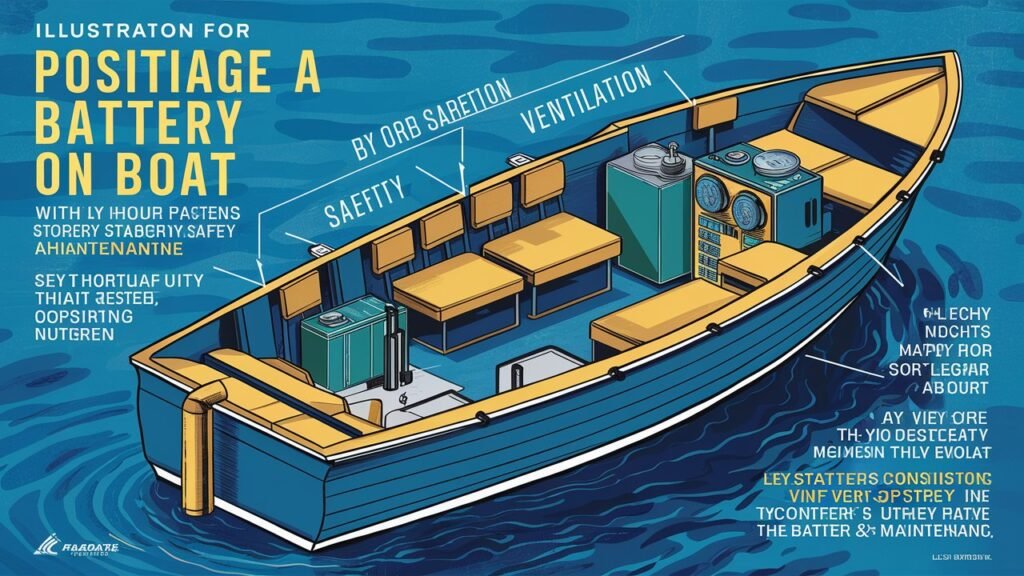Everything You Need to Know about Positioning a Storage Battery on a Boat
Marine batteries are essential components of a boat’s electrical system, providing power for everything from the starter to the electronics.
When positioning a storage battery on a boat, there are several important factors to consider.
First, you must choose the right sort of battery technology for your needs.
AGM batteries and deep cycle batteries are popular choices for marine applications since they are built to endure extremely harsh marine conditions.
Properly fastening the battery is also very important so that it will not self-discharge or get damaged when sailing a boat.
Another important consideration is the battery’s amount of charge.
To keep your batteries in good condition and prolong their life, recharge them regularly.
To do this, use either shore power connection, generator or the engine alternator of the boat.
Additionally, be sure to check electrolyte levels in traditional lead acid batteries and top off with distilled water as necessary.
Why is the Positioning of a Battery on a Boat Important?

Positioning the battery on a boat is crucial for several reasons. One of the main considerations is the type of battery being used – whether it is a start battery or a deep-cycle battery.
Start batteries are designed to deliver high amperage for short bursts to start the engine, while deep-cycle batteries are meant for long, slow discharges like running a trolling motor.
Placing the battery in the appropriate location ensures optimal performance and longevity.
Additionally, the position of the battery affects its connection to other components like the charger, battery switch, and trolling motor.
By positioning the battery close to these devices, you can minimize the length of cables required and reduce the risk of voltage drop, ensuring efficient power transmission.
Proper placement also minimizes the risk of corrosion and damage to sensitive electronics.
Furthermore, the orientation of the battery – whether it is in an upright position or lying flat – can impact its cycle life and overall performance.
Wet cell batteries must be kept upright to prevent leakage of sulfuric acid, while absorbed glass mat (AGM) and lithium batteries like lithium iron phosphate and lithium-ion batteries can be mounted in any orientation.
In conclusion, the positioning of a battery on a boat is essential to ensure reliable power for starting the engine, running electronics, and powering accessories.
By carefully considering the type, placement, and orientation of the battery, you can optimize your battery system’s performance, longevity, and safety.
Impact on Electrical System Efficiency

Electrical system efficiency can be greatly impacted by the condition and setup of the battery system.
Whether you have a single battery bank or multiple batteries, it is important to ensure that they are functioning properly to maximize efficiency.
A starter battery in a yacht or outboard boat, for example, plays a crucial role in the crank and charging process.
If the battery’s positive and negative terminal connections are not secure or if the battery is not at a full charge, it can shorten the lifespan of the battery and potentially regulator the efficiency of the entire electrical system.
Additionally, sulfation can occur if a battery is consistently undercharged or left in a discharged state for extended periods of time.
This can lead to irreversible damage to the battery and decrease the overall efficiency of the electrical system.
Implementing a solar panel or a new set of batteries with a charging process that can handle multiple amps can help maintain the efficiency of the battery bank and the entire electrical system, ensuring that all components work together without damage.
Effect on Battery Lifespan
Effect on Battery Lifespan
There are various factors that can impact the battery lifespan of a coast guard vessel.
One key factor is the voltage of the battery being used.
A higher volt battery typically has a longer lifespan compared to a lower volt battery. Another factor is the frequency of charging and discharging.
Overcharging or deep discharging can shorten the lifespan of a battery.
It is also important to consider the temperature at which the battery is being used, as extreme temperatures can also affect the lifespan.
Investing in high-quality batteries and following proper charging practices can help extend the lifespan of a battery on a coast guard vessel.
What are the Different Types of Batteries Suitable for Boats?

One battery suitable for boats is the traditional lead-acid battery.
These batteries are reliable and cost-effective, making them a popular choice among boat owners.
They are able to provide a steady source of power over a long period of time, perfect for extended trips on the water.
Another option is a lithium-ion battery, which is becoming increasingly popular due to its lightweight and high energy density.
These batteries are more expensive upfront but can be a great investment in the long run due to their durability and longevity.
Gel cell batteries are also a good choice for boats, as they are maintenance-free and can withstand rough conditions.
Lastly, AGM batteries are a reliable option that offers high performance and a longer lifespan compared to traditional lead-acid batteries.
How to Properly Install and Maintain Boat Batteries?
When out on the water, one should install and maintain boat batteries correctly.
Gel batteries are known for being low-maintenance deep-cycle batteries. If you want to get a battery for your vessel consider gel batteries which have low maintenance cost and deep cycling ability.
Before fixing it, ensure that the battery compartment is well ventilated and protected from weather elements.
Afterwards, secure the battery properly in place while fitting their terminals appropriately ensuring that they are tight and well fixed.
Regularly examine the battery for any corrosion or damage, clean up its terminals whenever required to prevent bad connection.
Avoid overcharging your battery to extend its lifespan and always follow manufacturer guidelines on regular maintenance.
By following this advice and doing proper installation of a boat’s battery, an individual can be able to enjoy an uninterrupted power during several years of his life.
Proper Battery Placement and Securement

The safety of a car can be determined on how well its battery has been placed and secured. Installation of the battery also needs to be done properly for efficient flow of electricity and to prevent corrosion.
Ensure that the battery is positioned in an area whereby it can be easily accessed for maintenance purposes during installation.
It is important to use securement devices like hold downs, or battery trays, which help in keeping the battery stable.
Regularly checking the condition of your battery and all connections will help avoid any problems and keep your vehicle’s electrical system working for a long time.
Regular Charging and Maintenance
Regular charging and maintenance are essential for prolonging the life of electronic devices.
There’s always enough power for the device to function well when you constantly engage it in charging.
Apart from this, regular maintenance such as cleaning, software upgrades and physical checks can forestall some problems and make the device work in a steady way.
To avoid damaging your battery, you should also use the correct charger and cable that match your device.
Battery life reduction, low performance levels, safety risks may be incurred by improper charging or neglecting necessary maintenance practices
It will guarantee that all your apparatuses are operating at maximum efficiency enhancing their lifespan.
Use of Battery Management System (BMS)
Battery Management System is important as it ensures that batteries perform better and last long in various applications.
A BMS is also charged with the responsibility of monitoring the charge states and health statuses of a battery thus giving real-time data to clients.
The information therefore allows users to know how much more energy can be taken from the cell before the next recharge is required.
Another important function of a BMS is to equalize the cells inside a battery pack so that they receive equal amount of charging and discharging in order to avoid overcharging or undercharging.
What Safety Measures Should Be Considered with Boat Batteries?
When it comes to boat batteries, there are several safety measures that should always be considered to prevent accidents and ensure smooth operation.
Let us start with the proper battery maintenance that involves regular examination of any corrosion or leakage.
Securing the batteries in place is also important to prevent them from moving or falling down when the boat is running.
Additionally, ensure that the charging of batteries occurs in a good area for air circulation and follow what the manufacturer says to avoid overheating them leading to fire catching.
Also, it is necessary to be careful when handling batteries as they contain dangerous chemicals which might burn if not taken care of properly.
Through these safety measures, individuals who have boats are capable of having reliable energy sources without endangering their lives and those of other people.
How to Choose the Right Battery Type for Your Boat?
For a successful experience at the sea, it is pivotal to ascertain that you have chosen the boat battery type appropriately.
There are numerous factors one should take into account while selecting the battery, such as its voltage, capacity, size and type.
Firstly you need to know your boats power requirements to determine appropriate voltage and capacity.
Ask yourself if you require a deep-cycle battery for long-lasting power or starting battery that can provide quick surges of energy.
Also pick an accurate size of the battery with regards to space available on board and weight limitations.
Additionally, select an established brand for quality purposes; this will guarantee durability and dependability.
By taking these factors into account, you can select the right battery type that meets your boat’s power needs and enhances your overall boating experience.
Considering Battery Capacity and Voltage Requirements
When considering Battery Capacity and Voltage Requirements for a device, it is important to take into account how much power is needed to operate the device efficiently.
The battery’s capacity is the energy that can be stored in it and usually given in milliamp hours (mAh) as units.
Higher capacities of batteries imply they would take more time before being recharged with higher use times.
Alternatively, a device’s voltage requirements indicate the amount of electric potential necessary to power it. Therefore, the battery should have the same voltage as that required by the device it powers so as not to risk damaging it.
Furthermore, some devices may require certain voltage levels in order to function properly and therefore one needs to check manufacturer’s specifications carefully.
To ensure your device performs optimally and lasts longer, you must consider both battery capacity and voltage requirements when buying a battery.
Conclusion:
For the boat to function properly, its storage battery must be carefully positioned.
So, whether it be for starting up the engine, using electronic equipment or driving some of your accessories; this is why you need a good position and safe attachment for your battery.
Choosing The right kind of battery such as AGM or deep- cycle batteries is the first thing one has to consider before positioning a storage battery on a boat. These batteries are made to endure harsh marine conditions and provide consistent power for long periods.
Voltage drop can be minimized and transmission of power optimized by how one positions his/her battery in relation with other components. Improper placement could also lead to corrosion on electronics which are delicate.




